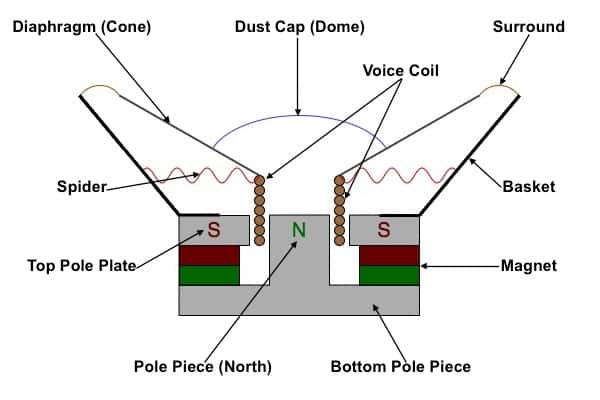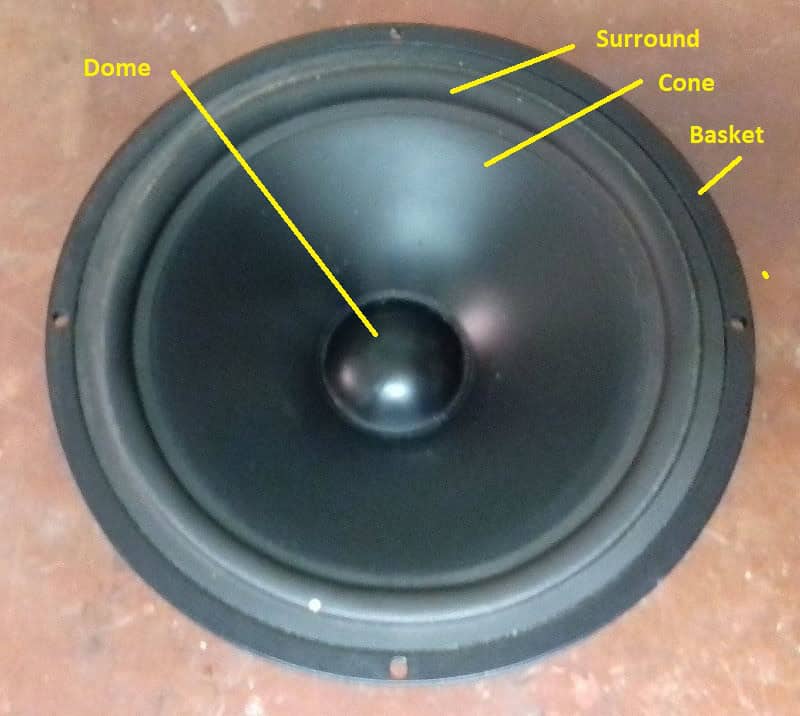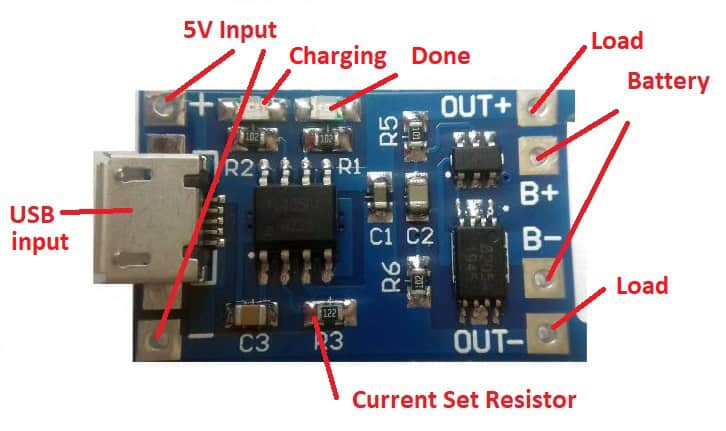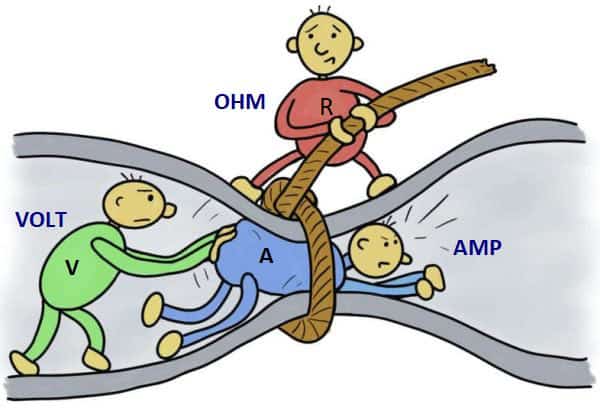Speakers convert the analog audio signal from an audio amplifier into sound waves that can be heard by the human ear. Speakers can be as simple as a passive buzzer, or as refined as a pair of HiFi audio speakers.
In this article, we will look at how speakers work, how to pick the right speakers for your amplifier, and how to calculate the power and current flowing through a speaker.
The Parts of a Speaker
Shown below is a cross-section of a speaker:

How Speakers Work
The audio signal is sent through the voice coil. This creates a magnetic field that changes with the polarity of the audio signal. The voice coil is positioned in a fixed permanent magnetic field created by the pole piece and the top pole plate. This causes the voice coil to vibrate up and down according to the audio signal.
The vibrating voice coil causes the diaphragm to vibrate, which produces sound waves in the air in front of the cone.
There are several different types of speakers, classified by the range of audio frequencies they can work with:
- Subwoofers – <20Hz to 200Hz
- Woofers – 20Hz to 2kHz
- Mid-ranges – 150Hz to 5kHz
- Tweeters – 2kHz to 20kHz
Speaker Specifications
The speaker should have a label that specifies the frequency range, impedance, power rating.
- Frequency range: the range of audio frequencies the speaker is able to reproduce.
- Impedance: Since the voice coil is inductive, speakers have impedance. The impedance you choose will depend on your amplifier. The user manual for your amplifier should tell you which speaker impedance to use.
- Power rating: Only RMS power (in watts) should be trusted. A 100w RMS speaker should be able to handle a 100w sine wave continuously
How to Find the Right Speakers for your Amplifier
Speaker impedance is the resistance of the speaker to audio signals from the amplifier. A lower speaker impedance implies that the speaker should be used with higher power amplifiers. A higher speaker impedance implies that a lower power amplifier should be used.
When speakers are connected in series, the impedances are added. For example, with two 4Ω speakers connected in series, the total impedance is 8Ω.
When connecting two speakers in parallel, the total impedance is divided by two. So with two 4Ω speakers connected in parallel, the total impedance is 2Ω.
Tube amplifiers demand the correct speaker impedance while solid-state amplifiers generally don’t care about matching impedances.
How to Calculate Amplifier Power
Consider an amplifier with an output swing of 21V RMS and 8Ω speakers connected. To calculate the output power of the amplifier with these speakers, use this formula:
P = V2 / R
Where
P: Output power (W)
V: RMS voltage of amplifier (V)
R: Impedance of the speaker (Ω)
With a 21V RMS output voltage and an 8Ω speaker, the power is:
P = 21V2 / 8Ω
P = 55W
This assumes the power supply has the ability to deliver this power.
How to Calculate Speaker Current
Now, how much current is going into the speaker? This can be calculated using Ohms law:
I = V / R
So in this example we have
I = 21V / 8Ω = 2.6A
Hope this article has helped you to understand how to choose the right speakers for your amplifier! Be sure to leave a comment below if you have any questions.






That was great. It began to answer some questions I’ve had (car 12V power), but it is still beyond me; even here, I question speaker impedance with AC in mind – I’m guessing this is beyond the scope of the article.
I do have a specific question: I’ve burned up reveivers, and I think I know the reason why. I have old speakers (set A) and other car speakers (set B) connected to A reveiver. I’ve added an additional driver to each “car speaker” to get each to 8Ω instead of 4Ω. Since I thought everyting was now OK, I once or twice, played both pairs (A & B) – the receiver burned up again (one channel). I then tested ire continuity and measured resistances of speakers and found one speaker (from set A) to be less than 8Ω – with both sets playing, this should be less than 4Ω, and thus why the channel burned up. Is this the likely reason?
And then, why don’t I see 16Ω woofers for sale to replace the woofers of the 2-way speaker systems? 24Ω for 3-way speaker systems?